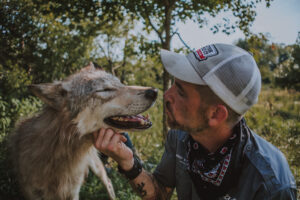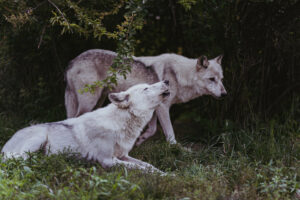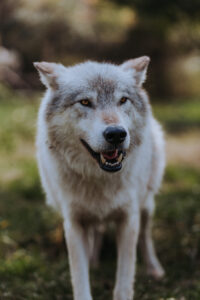By Colin McCandless, Contributing Writer

Photo/Ellora Sen-Gupta – courtesy of Wolf Hollow
IPSWICH – There’s something captivating and mysterious about wolves. Although long maligned in the public imagination due to unfair portrayals as vicious, bloodthirsty predators, today tourists flock to places like Yellowstone National Park for the chance to glimpse wolves in the wild.
Changing perceptions
Wolf Hollow, a nonprofit wolf sanctuary in Ipswich run by facility director Zee Soffron, aims to change people’s perception of wolves through education, advocacy and exposure. It helps to dispel myths surrounding wolves and remove the stigma associated with them.
“It’s our belief that when people come and see this animal firsthand, it’s going to leave an impression on them,” stated Soffron. “We want people to leave here knowing at least one more thing than they came with. Whether they’re a novice and know nothing or they know a few things about wolves.”
Zee’s father Paul Soffron founded Wolf Hollow, which achieved nonprofit status in 1988. It opened as a wolf sanctuary in 1990, when it brought in its first family of wolves. The first pup, Alyki, was born at Wolf Hollow in 1992. By 1995 Wolf Hollow had become an established educational conservation organization for wolves. They constructed a public viewing pavilion of the wolves in 1999.
Wolf Hollow currently features eight animals: seven pure wolves and one wolf-dog hybrid, ranging in age from two to 12. The oldest, Linnea, who will turn 13 in April, is the last surviving sibling of a litter of five introduced to the facility in 2011. They have three juveniles: Vilkas, Togo and Skadi, all turning two this spring. Siblings Akela, Qantaqa and Skully will be six this spring. Gaia is the wolf-dog hybrid. The property spans five acres and features a 23,000 square-foot main enclosure. They also have four auxiliary enclosures, ranging from 5,000-7,000 square feet, if they must separate individual wolves. The typical life span of a wolf in the wild is 13 years, but in captivity, they may live up to 16 years or more.
Wolf Hollow is purely educational, and wolves raised in the sanctuary live their entire lives there. They are all born in captivity, and pups are introduced to humans at approximately two weeks old when their eyes first open. “This is important as they come to see us as a trusted caregiver,” elaborated Soffron.
Hunted to extinction in New England

Photo/Ellora Sen-Gupta – courtesy of Wolf Hollow
Wolves were one of the first animals that early settlers encountered, and those initial confrontations devastated the wild population. “Sadly, Massachusetts was literally the first place that there was an official hunting program on wolves,” explained Soffron. “In as early as 1630, the Massachusetts Bay Colony had an official bounty encouraging settlers to kill as many wolves as they could.” While claims differ on the exact date of their extinction, it’s believed they were largely exterminated from New England by the late 1700s.
For skeptics who might question the significance of protecting wolves in the wild, Soffron offered multiple reasons. One is that they benefit human hunters. Wolves are skilled at targeting weak and sick prey that has been compromised, and in doing so, contribute to natural selection. They take the animals that hunters wouldn’t want, and for ethical hunters who relish a challenge, wolves “are keeping those animals smarter,” he related.
Considered a “keystone species,” wolves contribute to biodiversity and balanced ecosystems in big ways. When they were eradicated from Yellowstone in 1926, the park saw an overpopulation of herbivores like elk and mule deer. With no wolves to keep them moving throughout the park, they remained in one location and over browsed, eating vegetation down to the roots and denuding the landscape, including riparian buffers. When wolves were reintroduced, herbivores could no longer linger, and ultimately the root systems grew back stronger, the riverbanks were reinforced and river systems improved.
“Really, they’re contributing to a healthier landscape overall,” asserted Soffron.
Additionally, wolves provide for other predators, such as bears, coyotes and foxes, that will scavenge their kills. There’s also an economic advantage to having wolves. Wolf tourism has boosted Yellowstone visits, particularly in the winter months during down times, bolstering towns neighboring the park, commented Soffron. One June 2022 economic study found that wolf watching generates $82 million annually on average for local economies in Greater Yellowstone.
Dispelling myths

Photo/Ellora Sen-Gupta – courtesy of Wolf Hollow
Another fallacy surrounding wolves entails their ferocious reputation and penchant for attacking humans. Soffron cited the statistic that in the last 100 years in North America, there have been two documented human deaths caused by wild wolves. He characterized them as nurturing, amazing parents that typically mate for life. “Their willingness to accept puppies and take care of puppies—whether they are birth puppies or adopted puppies. They love raising pups.”
The best way the public can advocate for wolves, which face the dual threats of industrial ranching and big game hunting, is to be vocal and write to your elected officials supporting strong environmental protections and legislation like the Endangered Species Act said Soffron. As he noted, even though there are no wild wolves in Massachusetts, our senators vote on national policies affecting wolves. Soffron, who also works as a middle school teacher during the week, remarked that even those who can’t vote such as students can start fundraisers for Wolf Hollow or educate fellow peers about wolves through presentations.
If you go
Open year-round for public viewing on Saturdays and Sundays, Wolf Hollow offers guided tours and an educational program, as well as more informal tours for smaller groups such as families with young children. During the week they give tours to school, civic, and church groups, etc.
Principally, Soffron said it’s important to show the public wolves for the advocacy and educational components. “I want them to see the importance of this amazing animal and the fact that they are not a threat to humans,” he emphasized. “But also that they are beneficial, not just to the environment, but in other ways as well.”
Perhaps there’s also something primal about wolves that hits on a more visceral level. “Even just looking a wolf in the eyes for the first time is really huge for people. I think for a lot of people, it brings them back, even if just for a moment, to something that is inside of all of us that we’ve long forgotten,” mused Soffron.
For more information visit wolfhollowipswich.org.
RELATED CONTENT:
Essex and Ipswich remain havens for antiques lovers (fiftyplusadvocate.com)
Cape Poge showcases Chappaquiddick Island’s natural beauty (fiftyplusadvocate.com)
Leaving a legacy that matters – Fifty Plus Advocate












